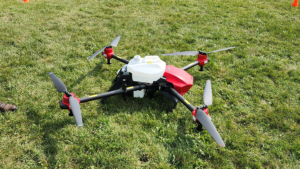Alternative weed control
ELECTRICITY AND ABRASIVE TECHNOLOGIES

THE RISE OF glyphosate restrictions and herbicide resistance issues are driving researchers to take a closer look at alternative weed control solutions.
Rob Nurse, a research scientist in the science and technology branch of Agriculture and Agri-Food Canada (AAFC), is leading multiple trials to evaluate what farmers could do to effectively control weeds without the use of herbicides.
“To ensure that Canadian growers remain competitive globally, cropping systems must be sustainable, profitable and environmentally sound,” he says.
Since controlling weeds and preventing yield loss would be more difficult without glyphosate, Nurse sees this research as a way to work towards alternative solutions so growers do not have to revert to older herbicide chemistries or tillage.
ELECTRIC ZAPPING
Electric discharge weeding works by forcing a current through a plant’s stem. The current boils the water inside the cells, which bursts the cell walls and kills the plant.
While it’s not necessarily a new technology, Nurse says it has received increased interest since an organic grower in Ontario imported a U.S.-manufactured unit called The Weed Zapper a few years ago.
The unit consists of a high voltage bar and discs mounted on a boom in front of the tractor and a generator mounted on the back, which electrifies the bar with 13,000 volts. There are now a handful of zappers across the province, and one is being used in research trials at the Harrow Research and Development Centre.
“We’ve been looking at it in organic cropping, but it can also be used in conventional cropping,” says Nurse. He’s specifically evaluating the effectiveness of electrification for pre-plant burndown and pre-harvest desiccation in dry beans compared to Eragon LQ.
HOW IT COMPARES
In 2021, Nurse evaluated its ability to control pigweed, lambsquarters, common ragweed and velvetleaf in one dry bean trial and one with no crop.
“We found that if we apply it at the same time as we would normally apply herbicide, we get a very similar burndown, and it also provides equivalent fall weed control,” he says.
As long as the weeds are 30 to 50 cm above the canopy, zapping doesn’t injure the crop or reduce quality.
Nurse has found that one pass is sufficient to destroy many species, but weeds that start to grow from their base, like pigweed and lambsquarters, may require several passes before they are killed off completely.
“From a weed control perspective, I think it’s a good technology, but it should not be used as a stand-alone program.”
As a pre-harvest desiccant, he believes it has excellent potential as a herbicide replacement in crops like dry beans. There is also potential to use it to burn down clover or other crops and control volunteer crops.
He is repeating the trials in 2022 and has proposed future research on in-crop weed control in dry beans, which would be directly relatable to soybeans.
SUCCESS IN SOYBEANS
Phil Oegema, an organic grower who operates Oegema Grains Ltd. near St. Thomas, was one of the first to bring The Weed Zapper to Canada three years ago.
He uses it for weed control in organic soybeans and dry beans in mid to late summer and has found it to be most effective on young, lush-growing weeds. He uses the machine an average of two times per season, depending on weed pressure.
“You can really clean up a messy field with this tool, and we’ve been very happy with how it has worked for us,” Oegema says.
While most current users are organic growers, he sees a place for it across all production systems and has received many calls from conventional growers interested in custom work.
“The machine works very well on Canada fleabane, so I definitely see a role for a tool like this on the conventional side as herbicide resistance continues to develop.”
HUNTING WEEDS
Nurse and three other AAFC scientists across Canada are also studying abrasive or projectile in-crop weed control in dry beans, potatoes, grapes, and blueberries.
Each researcher has a commercial sandblaster attached to an air compressor that can shoot corn grit, walnut shells, and a mix of both materials, in various sizes, at a rate of 480 kg per hectare.
Coined ‘weed hunting,’ this method will be evaluated over the next two years in small plots where some fields will be treated with only projectile materials and others will be treated with a combination of projectiles and herbicides.
“It’s all about the right timing,” explains Nurse, who is leading the dry bean component of the study. “We plan to shoot weeds at the same time that farmers might use a herbicide, so it fits into their regular schedule. It also lines up with when the weeds are just emerging from the soil and are most susceptible. They can absorb damage from the projectiles better when they get older.”
By 2024, the researchers aim to find the best projectile material and determine the ideal size and application rate for weed control of more than 80 per cent without significant yield loss or crop injury.
Nurse believes abrasives could be another solution for farmers battling resistance or wanting to reduce herbicide use. •
























